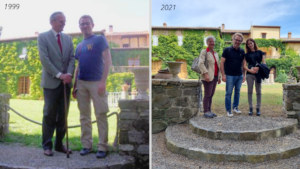 On July 8th I was thrilled to be invited to the estate of the renowned Brunello producer, Biondi Santi. I also had the pleasure to taste their magnificent wines. It has been a great honor for me to be back in the place where the legendary Brunello di Montalcino has been created.
On July 8th I was thrilled to be invited to the estate of the renowned Brunello producer, Biondi Santi. I also had the pleasure to taste their magnificent wines. It has been a great honor for me to be back in the place where the legendary Brunello di Montalcino has been created.
In the year of 1999, which was at the beginning of my career, I met the legendary Franco Biondi Santi in front of the 18th-century villa Tenuta Greppo. To this day, it is still a significant point of reference for my working and personal life in the world of wine.
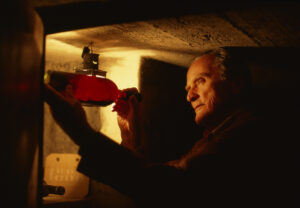
At that time [1999], I was a young boy with a drawer full of dreams.
I was welcomed at the beautiful entrance, of the wine estate, by Mr Franco Biondi Santi and I immediately perceived his humanity and kindness. For me, he was a passionate teacher, elegant and very enthusiastic. A charismatic man. After several years, I am back there with my team. We were welcomed by Sabine Cappelli from hospitality, and Lene Lundvald Bucelli from marketing and communications. They guided us into the discovery of the innovations of the estate, transmitting the same humanity and kindness that has always distinguished the Biondi-Santi family.
An endless success of “Great Men with a Vision”
There is an indissoluble thread between the success of one of the most important wine territories in the world such as Brunello di Montalcino and the history of the Biondi Santi family. The line of a dynasty of brilliant men; charismatic and visionary figures who have always been able to look forward. Masters of winemaking that managed to keep up the family name and their traditions. They’ve always taken care of their beloved territory of Montalcino. It was first the revolutionary intuition of Clemente Santi that in the 1850 decided to plant the Sangiovese variety at Montalcino. The name Biondi Santi comes from the will of his grandson Ferruccio, son of Caterina Santi (Clemente’s daughter) and Jacopo Biondi, to keep the grandfather name. Clemente and Ferruccio shared the same love for viticulture and vinification. The name Brunello di Montalcino (with capital B) on the label was first seen in 1888 under the guidance of the latter. Ferruccio Biondi Santi also noticed the robust character of the Sangiovese Grosso grape and decided to vinify it on its own to produce wine suitable for aging.
Another turning point was in 1966 when Tancredi (Ferruccio’s son) established the specification when the DOC was created for the Brunello di Montalcino (then upgraded Docg in 1980). The other brilliant visionary of the last century was Franco Biondi Santi (1922-2013) who learned from his ancestors the fine art of vinification. As a wine producer he meticulously continued the growing practices and further enhanced the already cult wine of Montalcino. He carried on the study begun by Ferruccio and continued by Tancredi on the research of a grape that was the most resistant to the cryptogams that were affecting their vines. The selection process concluded with the identification of the clone known as BBS11: which stands for Brunello Biondi Santi with the 11 corresponding to the chosen mother plant. Biondi Santi is the only producer to have given its name to a grape clone.
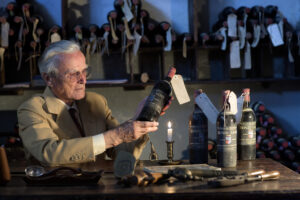 After many years and long tradition in the wine production, the new generations of the family, Jacopo Biondi Santi and his son Tancredi Biondi Santi initiated a major change and evolution for Tenuta Greppo, welcoming a new partner in the leading of the estate to be able to continue the enduring commitment of producing outstanding wines. Today the winery is under the guidance of Christopher Descours, proprietor of the EPI Group, who leads hand in hand with an extremely qualified Italian team. An important strategic alliance driven by the great respect for the bicentenary know-how in the vine growing and by the common goal of reaffirming once again Biondi-Santi among the most special and desired wines in the world. The vision of the new partner was endorsed immediately by Giampiero Bertolini who was appointed as CEO in November 2018 standing at the helm of the historic winery today.
After many years and long tradition in the wine production, the new generations of the family, Jacopo Biondi Santi and his son Tancredi Biondi Santi initiated a major change and evolution for Tenuta Greppo, welcoming a new partner in the leading of the estate to be able to continue the enduring commitment of producing outstanding wines. Today the winery is under the guidance of Christopher Descours, proprietor of the EPI Group, who leads hand in hand with an extremely qualified Italian team. An important strategic alliance driven by the great respect for the bicentenary know-how in the vine growing and by the common goal of reaffirming once again Biondi-Santi among the most special and desired wines in the world. The vision of the new partner was endorsed immediately by Giampiero Bertolini who was appointed as CEO in November 2018 standing at the helm of the historic winery today.
Vineyards and Soils
Since 2018, huge investments have been made. The new partnership carried on the scientific research of Franco, who introduced a rigorous study on the parcellation both in the vineyards and in the winery depending on the age of the vines. It shows the extraordinary effort of the leaders of the estates to try to understand and develop their beloved terroir. An accurate examination in the professional hands of the agronomist Pietro Parra starting from the analysis of the vineyards, and taking a fresh approach to the terroir. He has been able to fully map the characteristics of all the different types of soil and exposition. The estate today is comprised of 47 hectares. All the grapes are from different vineyards that extend between the four historical sites Tenuta Greppo, I Pieri, Scarnacuoia, Pievecchia and the new acquisition Ribusuoli.
“Tenuta Greppo”, is the main block around the winery, 560 metres above sea level. It is situated on a 26-hectare, coming from a massal selection of the oldest vines of the property dating back to 1930, the majority of them are BBS11 clones (Brunello Biondi Santi 11).
“I Pieri”, east of Montalcino, sitting at 370 metres altitude with a cool east-facing exposure, like Greppo, are poor, calcareous soils with a high marl content.
“The Scarnacuoia” on the west of the village Montalcino, at 450 metres altitude with old-terraced vineyards separated by dry stone walls.
“Pievecchia”, the lowest lying site, at 200 metres altitude with a cool, airy, north facing exposure. The soil here has a higher clay content.
“Ribusuoli”, is a plot acquired at the end of 2019 at an altitude of 380-450 metres, not far from Tenuta Greppo, with very similar soils and exposures.
Biondi-Santi is committed to respecting the environment and safeguarding biodiversity. Today, as in the past, the vineyards are not treated with any invasive chemical agents.
The Winery and its Wines
New concrete and oak vats were purchased to maintain the winery’s tradition of the use of concrete for fermentation and Slavonian oak for ageing. The grapes are destemmed and crushed upon arrival at the winery. Only indigenous yeasts are used for fermentation of the riserva. The process takes place in oak vats, unlike the regular Brunello, which ferments in concrete vats. Federico Radi, the technical Director in charge of the wine production, is focused on continuing the balance between tradition and innovation. Biondi-Santi produces three wines, all crafted with Sangiovese Grosso: Rosso di Montalcino; Brunello di Montalcino; and Brunello di Montalcino Riserva. All three wines are bound together by a distinctive style, driven by a signature freshness, which makes them vibrant, and a specific balance which makes them elegant and very suitable for long ageing in the bottle.
My tasting at Biondi-Santi, Tenuta Greppo on the 8th of July 2021
Rosso di Montalcino Doc 2018
The Rosso di Montalcino 2018 was produced exclusively from Biondi Santi proprietary vineyards and aged in Slavonian oak barrels for 12 months and released on the market after 3 years from the harvest.
100% Sangiovese Grosso – Alcohol 13%
Notes:
Brillant medium ruby core with compact rim. Expressive flavour of strawberry, blueberries, and violet mixed with scents of rhubarb and mint. Lively red fruit in the palate with abundant freshness and well-integrated tannins. Elegant and lingering finish. Charming wine with ageing potential.
Brunello di Montalcino Docg 2015
The 2015 Brunello was produced exclusively with a selection of grapes from Biondi Santi proprietary vineyards, then aged in Slavonian oak barrels for 3 years and released on the market after 6 years from the harvest. For the first time in history Biondi-Santi, this wine was produced in 750 ml and Magnum bottles.
100% Sangiovese Grosso – Alcohol 14,5%
Notes:
Bright deep ruby core with narrow rim. The wine expresses intense aromas of black cherry and plum mixed with scents of chocolate and fresh tobacco. The palate is balanced, the acidity matches perfectly with the soft tannins and with the alcohol. Harmonious structure with long aftertaste. A beautiful wine.
Brunello di Montalcino Docg 2013 Riserva
The 2013 Riserva was produced exclusively with a selection of grapes from Biondi Santi proprietary vineyards comprising of the oldest parcels, then aged in Slavonian oak barrels for 3 years and released on the market after 7 years from the harvest.
Vintage 2013 is officially the 40th Riserva produced from 1888 until 2013. For the first time in history Biondi-Santi produced three large formats in addition to the 750 ml bottle: Magnum, Jéroboam and Mathusalem.
100% Sangiovese Grosso – Alcohol 13,5%
Notes:
Intense ruby core with paler reflections. Very complex nose showing aromas of red cherry and blackcurrant. Slightly meaty with overtones of cedar and leather. Vibrant, fresh palate with velvety tannins well matched with a lovely fruit and a lively acidity. Soft and persistent. An outstanding wine, clear expression of pure Sangiovese with long lasting life.
Brunello di Montalcino Docg 1983 Riserva
The 1983 Riserva was produced with the Biondi Santi proprietary clone of Sangiovese Grosso called BBS11 (Brunello Biondi Santi 11), which was identified and selected by Biondi-Santi at Tenuta Greppo in the Seventies. For this wine were used only grapes from the oldest vines with over 25 years of age, then it was aged in Slavonian oak barrels for 3 years and released on the market generally after 7 years from the harvest. It benefited from a long refinement in the bottle in the quiet and darkness of “La Storica”, the bottle library at Tenuta Greppo where all the historic vintages of Biondi-Santi Riserva are scrupulously kept.
100% Sangiovese Grosso – Alcohol 13 %
Notes:
Clear, garnet colour with paler tinge. The nose shows a magnificent bouquet with scents of prune and fig with hints of mushroom and tobacco. Delicate entrance in the palate with medium body and silky tannins. It shows equilibrium and finesse. A gorgeous wine, showing the purity and the potential of one the greatest Sangiovese in the world.
Tenuta Greppo and its terroir are a place of perpetual balance. Each bottle produced is unique and alive, growing without hurry in its charming relationship with time. It is a wine that maintains not only the great quality that has always distinguished the company, but it also assumes unique features year by year. Prolonged bottle-ageing is then essential to allow the Biondi-Santi style to develop to its fullest. Longevity is in fact the most precious quality of these wines. “It is intriguing to think that in a sip Brunello di Montalcino there are hidden all of the three temporal dimensions: the past with the history of a family and their dedication to viticulture, study and research; the present with lively, complex and intense flavors; and the future, that lies in the ability to grow in character, both its wines and its representatives.” Here they’ve always seen beyond the horizon, setting ambitious objectives. Pioneers that created what is considered today the finest expression of the Tuscan wine style.
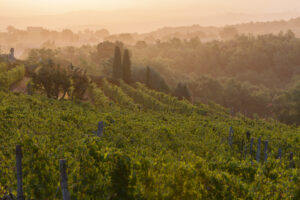
Biondi Santi is the spearhead of one world famous wine destination. Wine lovers and wine professionals arrive in Tuscany from all over the world for their exceptional wine travel experience.
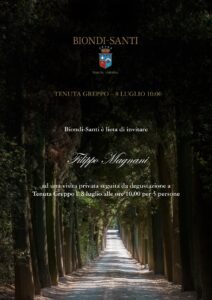
#Biondisanti #wine #redwine #winelovers #instawine #winetravel #winetourism #italy #tuscany #tenutagreppo #behindthebottle #italianwine #italianwinelover #tuscanygram #Sangiovese #winetasting @biondisantigreppo





